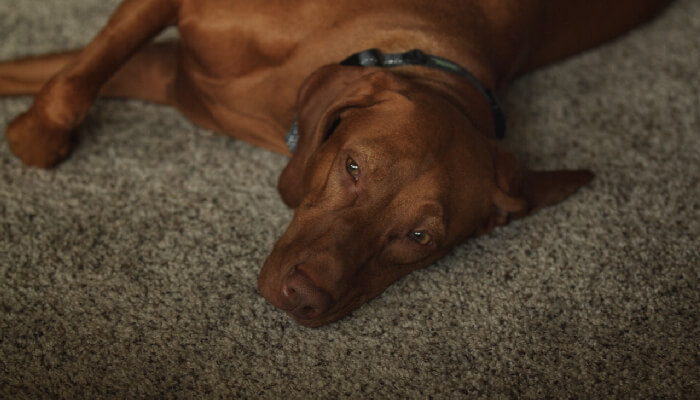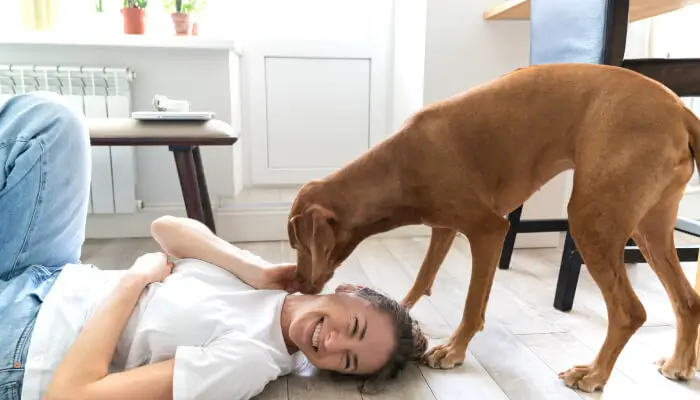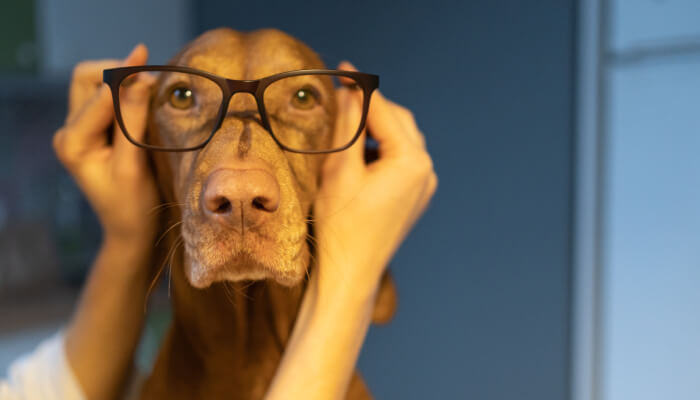Vizslas are large dogs, and that’s one of the reasons they have bumps on their skin. Unfortunately, they also suffer from “vizsla itch,” a common problem among Vizslas.
So why do Vizslas get these bumps? Vizslas usually get bumps due to allergies, environmental conditions, unhealthy food habits, disease, parasitic infections, and disturbance in their body functions.
Further, why does my vizsla seem to be scratching all the time? Finally, why does my vizsla has bald spots on his body? These are just some of the questions we’ll answer in this article.
What Are Bumps?
Bumps are little raised areas that don’t have a sac. And lumps are masses of tissue that is small and round. When it comes to dogs, people often use this term interchangeably with “node”, usually referring to lymph nodes or other structures such as fat pads, sebaceous glands, or hair follicles.
Why Do Vizslas Get Bumps?
Bumps are usually a sign of an infection, but there are several types. The kind that you will find on your Vizsla dog is mostly cysts or clusters of bumps. But the size and number depend on the type of bump they have and the causative agent of infection.
If you Vizsla has bumps, you might be looking for its cause. So, here are few reasons why Vizslas get bumps.
- The top reason for bumps on a vizsla is from mosquito bites. Lately, there has been an increase of ticks in certain regions where they have not historically existed before.
- They can develop a bacterial infection by scratching or biting the skin around their neck, back of the head, and spine region, often leading to abscesses that need veterinary attention.
- Shock waves from loud noises like thunderstorms, fireworks, gunshots, and explosions can cause an animal’s hair to stand up. And make it feel like bugs are crawling on them, leading the dog to scratch or bite at its skin;
- Other causes of bumps in Vizslas include hip dysplasia, allergies, excessive grooming by licking their coat too often.
Should I Worry About The Bumps In Vizslas?
Many people worry about the bumps in vizslas and their health. The most common cause of skin bumps on a dog is flea bites or scabies mites, which humans and dogs can contract. These are treatable conditions that should not last more than two weeks.
If there are no other symptoms, only itchiness, you can treat them easily with topical ointments like cortisone cream. Itchy red spots on a Vizsla can be due to a variety of factors that are typically harmless. But still, it is best to consult a veterinarian as soon as you notice bumps in your Vizsla.
What Are The Types Of Bumps Vizslas Can Have?
Since the cause of bumps varies a lot, you will notice different types of bumps in your Vizsla. And the most common ones are:
Cyst-Like Bumps In Vizslas
If your dog has cyst-like bumps, this is a form of follicular dermatitis due to either parasitic infections or allergies. In the case of parasites, you will see them as lumps that are red with little black specks on top, and they usually occur in the head and neck region. Allergies might look like a collection of clusters that are red and may have a thickened edge.
If your dog has bumps on its skin, it is important to know the difference between cysts and other types of bumps for correct treatment. When the Bumps look more like cysts, you will need to visit your veterinarian as soon as possible because of parasitic infection or allergies. If you have other types of bumps that look more like ulcers, then your dog might have pyoderma. And you will need antibiotics to treat your dog’s skin before the case becomes worse.
Medium-Sized Firm Bumps In Vizslas
Vizslas can get firm bumps that are not yet ready to come out. These medium-sized bumps will be between the size of a pea and marble, but they won’t spread as easily or quickly as other skin issues do. However, owners need to monitor these bumps since they could grow into a large skin tumour if left alone in one spot when these bumps occur.
These bumps are often red, and you can feel them as a firm lump. The cause is anonymous, but they may be due to insect bites, lice or ticks. And continuous scratching can make these infections worse. On rare occasions, these bumps may turn into skin ulcers. So, it is best if you talk to the Vet for treatment as soon as possible.
Clusters Of Bumps In Vizslas
Vizsla’s can also have clusters of bumps that are slightly redder than the surrounding area. These bumps will only be on one small dog section and not spread to other areas like cysts can do. If the skin on a Vizsla dog can move freely over these bumps, they are very likely not cysts.
Vizslas can also get clusters of bumps around their face. These deep, painful lumps on the skin are usually large in size and will often start to grow after a few days or weeks have passed. One common cause for these types of bumps is due to untreated parasites within the dog’s body.
What Are The Most Common Bumps And Lumps In Vizsla?
Usually, you can define lumps as the areas where the skin of your Vizsla rises abnormally and becomes hard and rigid. And the types of lumps are:
Hives And Allergies
Hives are a manifestation of an allergic reaction, and insect stings your Vizsla. They can happen to any animal. But they tend to be more common in dogs than other animals because their fur makes it easier for the allergens to contact their skin.
If your Vizsla is reacting, they will probably develop hives on their belly and chest areas first, but over time it can spread out all over their body. Hives are usually red or pink in colour, raised off the dog’s skin, and can be anywhere from a dime to as large as an orange.
Hives are often itchy and irritating, but they do not cause any pain for your Vizsla because there is no inflammation in this form of allergic reaction. Your dog may lick or scratch. If your Vizsla is experiencing hives, then it’s likely that they are also suffering from an allergic reaction to something in their environment, such as pollen or dander.
Papules And Pustules In Vizslas
Papules and pustules in Vizsla dogs are basically skin bumps. What causes these types of bumps is anonymous. But the most popular theory suggests that allergies or hypersensitivity reactions are a leading cause. These could be due to exposure to an allergen like pollen from grasses, trees etc., which triggers a hypersensitive reaction in the skin.
There are two types of bumps vizsla dogs can have Papules and pustules; cyst-like bumps. The size, shape or whether they form clusters (papules) on the dog’s body. When these bumps are cyst-like, they will be painless to touch and do not cause any itching. What’s more, these bumps can also form clusters on the dog’s body or in one particular area.
Skin Tag In Vizslas
The common type of bump in a Vizsla is a skin tag. Skin tags are small and harmless growth on the surface of your dog’s skin or beneath its haircoat that typically will have rounded edges, like a tiny banana peel. They can be pink, brown or tan colour with a rough, scaly surface. Skin tags are harmless and will stay with your dog for its entire lifetime.
However, sometimes skin tags can become infected. So what is the treatment for it? This infection occurs if your dog is in an immunocompromised condition. And this causes him to be more susceptible to a bacterial or viral infection. Treatment of an infectious skin tag involves clipping off the “bean” at its base with sterilized scissors (do not forget gloves!), followed by cleansing the site with an antiseptic solution.
Hemangiosarcomas In Vizslas
The other type of bump in a Vizsla is hemangiosarcomas. A type of cancerous tumour originates from the cells lining the blood vessels and progresses to form large lumps under the skin.
Hemangiosarcoma tumours can be present anywhere on your dog’s skin, from the nose to the tail. Treatment usually includes surgical removal of the lump and chemotherapy with a drug called doxorubicin or other effective medication against cancerous cells.
Sebaceous Cysts In Vizslas
Sebaceous cysts are sacs that form a comedo (or blackhead) on the skin. They appear when a pore clogs with sebum and keratin, present in hair and skin cells. These bumps have an opening at one point through which it can release the fluid and debris inside.
If your Vizslas have sebaceous cysts, you need to clean them regularly with warm water using cotton or gauze pads to prevent infection and breakouts. Also, don’t forget to dry the area after washing to avoid irritation.
Sebaceous cysts can appear as light-coloured bumps on a dog’s skin. You will more likely see them near the face and ears. Since sebaceous glands produce the sebum, this can cause a buildup of cells and debris near the openings to these glands. These cysts contain fluids made up of sebum as well as dead skin cells.
Mast Cell Tumors
Mast cells are a type of immune cell present in the skin and tissues. They play an important role in helping our body heal but can also cause problems when they release chemicals that cause swelling or pain. Mast cell tumours occur when an abnormal number of mast cells form in the skin or other tissues, and some can be benign or malignant cancers.
Mast cell tumours may not always be easy to see. Some mast cells produce few symptoms, making it difficult for a veterinarian or other health care provider to diagnose them by sight alone. If your dog has lumps in Vizsla, they may have a type of mast cell tumour called an eosinophilic granuloma (sometimes just called “granuloma”). These are cyst-like bumps, and they may have a scaly, red or white appearance.
Lipoma In Vizslas
Lipoma is a benign tumour that usually occurs on the skin. But you can also find them deep within the subcutaneous tissue. Vizslas get these lumps as they age, and their immune system weakens.
A lipoma may appear to be any size or colour, but most commonly, they are soft and rubbery. What you need to know is that lipomas grow slowly. So, it may take weeks or months for a lump to appear. If your dog’s bump doesn’t go away after ten days of treatment with antibiotics, steroids, or antiparasitic medications, you should see your vet.
Squamous Cell Carcinomas In Vizsla Dogs
Squamous cell carcinomas are a type of skin cancer in Vizsla dogs. Although, it is not the most common kind of skin cancer in Vizslas (basal cell carcinomas affect about 90% of all canine cancers). But your dog can have this type after exposure to trauma or sunlight over their lifetime. Signs of squamous cell carcinomas are:
- Your dog may have distinct lumps
- The skin over the bumps will look red or purple and crusty, especially if you try to pick at them.
- There’s a chance your doggy could lose patches of hair (or the whole coat)
- The hair that’s still on their body may look thin or broken and brittle
- Your dog may have open sores that won’t heal
- Vizsla might have inflammation or sore skin when you touch.
- There’s a chance your doggy will look “scrawny,” with little fat on their body.
Histiocytomas In Vizslas
Histiocytoma is a benign tumour in histiocytes cells. Histiocytes are white blood cells that look like stars and produce antibodies in response to injurious stimuli. These bumps can often be purple or red and are present under the skin, around joints, and internal organs such as the liver, spleen, lung, or heart.
Histiocytomas are uncommon among Vizslas. What makes them even more unusual is that you may find them in clusters. So, owners often confuse them with a malignant tumour like melanoma or histiocytic sarcoma. However, unlike these two types of tumours, histiocytomas do not spread to other parts of the body or grow back after surgery.
What Should I Do If My Vizsla Dog Has Skin Bump?
It is important to note that any bumps in the skin or hair loss are not normal and can be of concern. However, some bumps come and go naturally. Yet, it would help if you were careful that the bumps in your Vizsal’s body don’t last more than a week or two.
Usually, you can follow the following tips if your Vizsla has bumps:
- First, clean the area and apply a topical ointment.
- Change your dog’s diet to exclude fatty foods, dairy products, and chocolate since they can be allergic triggers for dogs.
- Examine other symptoms such as fever or persistent itching to find out more about what is causing the bumps on your Vizsla.
- If you are still not sure, and if your Vizsla has skin lesions that do not seem to disappear or gets worse, it is better to see a veterinarian.
If you notice any bump on your dog that is sore or sensitive to touch and it does not come off easily, then you should take them to the vet for a skin test. But don’t try and remove any bumps on your dog.
Conclusion
Vizslas are a beautiful dog breed with many adorable traits. One thing you may notice about your vizsla is the bumps they can get on their skin, which often look like acne or zits. These pumps come in different shapes and sizes, but there’s no need to worry if yours has them. It could just be an indication of where he needs some extra care from his owners.
If this sounds like something that might be happening to your furry friend, we recommend reading our blog post for more information on what these types of bumps mean. So, you know how to treat them appropriately. Have any other questions?



